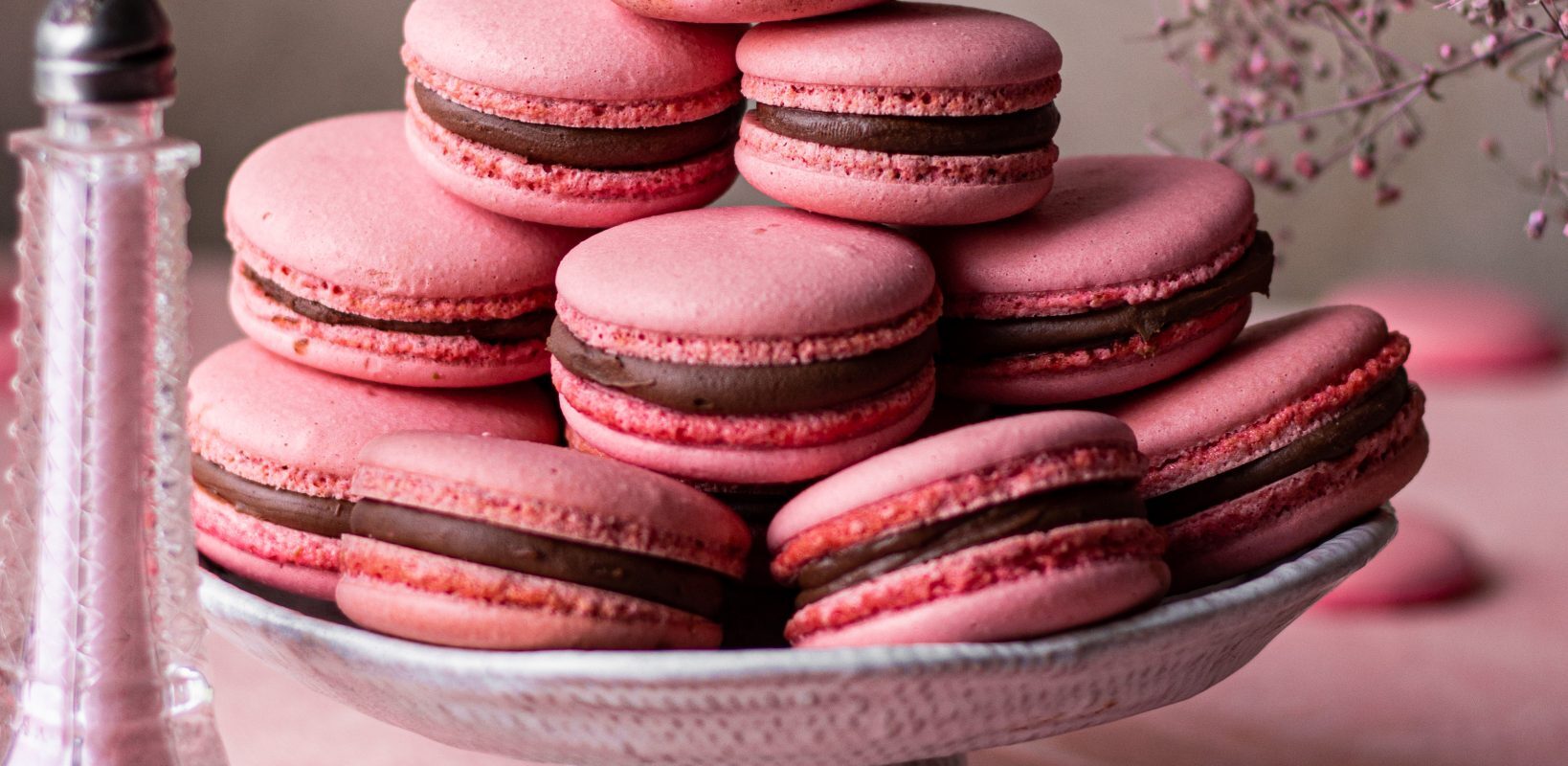With the holidays around the corner, it would be a good time to make your own impressive edible gifts or to use them as a “load-shed-proof” dessert.
This easy-to-make Raspberry Macaron filled with Dark Chocolate Ganache recipe will guide you to have fun while making an impressive dessert. Macarons have a fairly long shelf life of 7 days at room temperature and up to 7 weeks when kept chilled.
We have included a recipe for the homemade raspberry jam used to fill the Raspberry macarons but feel free to use store-bought jam. The best, of course, would be to grow your own red, yellow, black or purple raspberries at home… Contact us for berry plant material, but in the meantime, let’s get to the recipe.
Apart from the recipe below, here is a YouTube video that shows you the process as well as a few tips on the meringue stiffness, better consistency, shape etc.
Recipe
Prep Time: 2 hours
Cook Time: 40 minutes
Servings: 20 macarons
Calories: 150kcal
Ingredients
Raspberry Macaron Shells
4 grams of egg white powder. It works great, but is optional- Read the notes below
100 grams of egg whites
100 grams of white granulated sugar
105 grams almond flour
105 grams powdered sugar
A few drops of fuchsia (or similar color) food coloring
Raspberry Jam
1 cup raspberries fresh or frozen (250 grams, 10 oz). Again, you can grow your own raspberries.
1/4 cup granulated sugar. Use maple syrup or another sweetener as an alternative
1 tbsp lemon juice
1 tbsp cornstarch (Maizena)
1 tbsp cold water
Dark Chocolate Ganache
115 grams (4 ounces) of dark chocolate
1/4 cup heavy cream (60 grams)
Instructions
Raspberry Macaron Shells
Before you start, get all of the ingredients ready. Prepare a large piping bag, fitted with a large round tip. The 12mm (1/2”) diameter tip works well. Set aside.
Line two baking sheets with parchment paper or a silicone mat.
Measure out all of the ingredients.
Sift the powdered sugar and almond flour together. Set it aside.
Whisk the sugar and the egg white powder (if using) in a bowl, and place it over a pan with barely simmering water. Add the egg whites to the sugar and whisk the mixture until frothy and the sugar is completely melted. It will take a couple of minutes. You can test by touching the mixture between your fingers, and if you feel any sugar granules just keep whisking the mixture over the water bath.
Make sure the bottom of the bowl isn’t touching the simmering water because you don’t want the whites to cook.
Also, don’t overheat the sugar syrup, this may cause issues later on, such as wrinkly macarons.
Transfer the syrup to the bowl of a stand mixer.
With the whisk attachment, start whisking the mixture on low for about 30 seconds, then gradually start increasing the speed to medium. Whisk on medium for one to two minutes, until the mixture is white and starting to become fluffy. Raise the speed to high, or medium-high and whisk for a few minutes until stiff peaks are formed. The best way to check this is to keep your eye on the whites. Once they get glossy and you start seeing streaks formed by the whisk, it might be time to stop.
Whisk until stiff peaks have formed. When you pull your whip up, the peak should be stiff when the peaks are pointing upwards, with possibly a slight bend at the top, but not bending easily down to the side.
Pour the sifted powdered sugar and almond flour into the stiff meringue.
Add the food coloring at this point, if using. Fuchsia gel food coloring works great, but rosy pink mixed with red also works well if you can’t find Fuchsia. The idea is to get to a pinkish-red hue that compliments the raspberry macaron.
Start folding gently forming a letter J with a spatula.
How to know when to stop folding the batter: It’s time to stop folding when the batter is glossy and has a thick and flowing consistency. There are several ways to test this.
First, pick up some batter with the spatula and try to draw a figure 8 with the batter that is dripping off the spatula. If you can form several 8 figures without the batter breaking up, that’s one indication that it might be ready. The video shows this method if this is unclear.
There’s another test you can do. – The Teaspoon test. Grab a teaspoon of batter and spoon onto the parchment paper or silicon mat. Wait a minute to see how it behaves.
If the batter stays stiff, forming a point and doesn’t spread out, fold a little bit more, about 3 folds. Test again.
Once the batter spreads out a bit and starts to look glossy and smooth on top, of the parchment paper or silicone mat, it’s ready.
You don’t want your batter to be too runny either. So be careful not to overmix. It’s always best to undermix and test several times until the proper consistency has been achieved.
When you hold the spatula with batter on top of the bowl and the batter falls off the spatula slowly but effortlessly the batter is ready. The batter will keep flowing off the spatula non-stop, but not too quickly.
Transfer the batter to the piping bag.
Place the piping bag directly 90 degrees over the center of each macaron template. Apply gentle pressure and carefully pipe for about 3 seconds, and then quickly pull the bag up twisting slightly.
Once you’ve piped as many circles as you could, bang the trays against the counter a few times each. This will release air bubbles that are in the batter and prevent your macaron shells from cracking.
Use a toothpick to pop any air bubbles on the surface of the shells.
Let the trays sit for a while so the shells will dry out a little bit. It usually takes about 20-40 minutes, depending on how humid the day is. You’ll know they’re ready when you gently touch the surface of a macaron and it seems dry.
Preheat the oven to 150ºC (300ºF).
Bake one tray at a time.
Bake for 5 minutes, rotate the tray 180 degrees sideways so that the macarons closest to the oven door can be at the deeper end of the oven to ensure even baking.
Bake for 5 more minutes. Rotate again.
I bake each tray for about 15 to 20 minutes.
When baked, the macarons will have a deeper color and formed feet. If you try to move a macaron, it shouldn’t feel jiggly. If the macaron is still jiggly, keep baking.
Remove from the oven and bake the other tray.
Let the macarons cool down before proceeding with the filling.
Raspberry Jam
Mix the raspberries, sugar (or sweetener or choice), and lemon juice in a small pot. Bring to a boil over medium heat, and cook, stirring for about 5 minutes. Use the spoon to break up the raspberries as you stir.
Mix the cornstarch and cold water in a small bowl.
Once the raspberries have boiled and reduced a bit, add the cornstarch and water mixture to the pan.
Bring back to a boil, stirring constantly, until the mixture has thickened.
Pour through a strainer, and keep on stirring the mixture to strain the jam. Make sure to press it through really well so you can get the most out of it, and just leave the seeds behind. The raspberry seeds are fairly small, so if you like the seeds, just skip the straining.
Let the jam cool. Cover it with plastic wrap and place it in the fridge.
Dark Chocolate Ganache
Chop the dark chocolate very finely, or skip if using chocolate chips. Place it in a bowl.
Heat the heavy cream in a small pan over medium heat, or in the microwave. No matter what method you choose, be very careful not to boil the heavy cream.
Pour the hot cream over the chopped chocolate and let it stand for a minute.
Start stirring with a spatula until the chocolate is completely melted.
Let it cool to room temperature. Refrigerate for a bit before using until it has piping consistency if you want to speed up the process.
To achieve the piping consistency, the ganache has to be at room temperature of around 25ºC.
If it has been in the fridge for a while, and it’s too thick and hard to pipe, insert it in the microwave for a few quick seconds, and stir it again. Test for consistency and keep going until you achieve the desired consistency.
To be pipeable, the ganache should be thick, but easy to spread.
If it happens that the ganache is too thin, you might want to put it in the fridge for a few minutes so it will harden up.
As mentioned before, you need to keep testing to get the perfect consistency.
Grow your own berries
Berries for Africa is a contract nursery grower and supplier of various berry plants. Apart from supplying plants, we offer turnkey consultation services for your specific production system whether you are a commercial berry farmer or enthusiastic home-grower. These services include soil testing and rectifications, planting, fertilising, trellising, hydroponic systems, integrated pest and disease management, pruning, harvesting, and last but not least, the marketing of your fruit. For berry plant material or more information about orders or services, feel free to contact us at info@berriesforafrica.co.za


